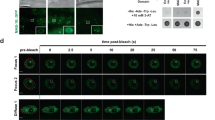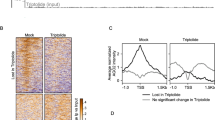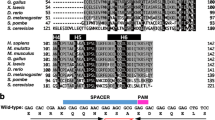Abstract
SAYP is a dual-function transcriptional coactivator of RNA polymerase II. It is a metazoan-specific factor involved in different signaling pathways that control normal development. In Drosophila, SAYP is present in the organism from the early stages of development and participates in cell cycle synchronization at the blastoderm stage. SAYP is abundant in many embryonic cells and in imaginal discs of larvae and is crucial for oogenesis in adults. At the molecular level, SAYP serves as a basis for assembling the BTFly nuclear supercomplex consising of the Brahma and TFIID coactivators. We suppose that BTFly and other similar nuclear supercomplexes play an important role in ontogenesis.
Similar content being viewed by others
References
Lemon, B. and Tjian, R., Orchestrated Response: A Symphony of Transcription Factors for Gene Control, Genes Dev., 2000, vol. 14, pp. 2551–2569.
Naar, A.M., Lemon, B.D., and Tjian, R., Transcriptional Coactivator Complexes, Annu. Rev. Biochem., 2001, vol. 70, pp. 475–501.
Taatjes, D.J., Marr, M.T., and Tjian, R., Regulatory Diversity among Metazoan Co-Activator Complexes, Nat. Rev. Mol. Cell Biol., 2004, vol. 5, pp. 403–410.
Shidlovskii, Y.V., Krasnov, A.N., Nikolenko, J.V., et al., A Novel Multidomain Transcription Coactivator SAYP Can also Repress Transcription in Heterochromatin, EMBO J., 2005, vol. 24, pp. 97–107.
Vorobyeva, N.E., Soshnikova, N.V., Nikolenko, J.V., et al., Transcription Coactivator SAYP Combines Chromatin Remodeler Brahma and Transcription Initiation Factor TFIID into a Single Supercomplex, Proc. Natl. Acad. Sci. USA, 2009, vol. 106, no. 27, pp. 11049–11054.
Georgiev, P.G., Identification of Mutations in Three Genes That Interact with zeste in the Control of White Gene Expression in Drosophila melanogaster, Genetics, 1994, vol. 138, pp. 733–739.
Grzybowska, E.A., Wilczynska, A., and Siedlecki, J.A., Regulatory Functions of 3’UTRs, Biochem. Biophys. Res. Commun., 2001, vol. 288, pp. 291–295.
Aravin, A.A., Naumova, N.M., Tulin, A.V., et al., Double-Stranded RNA-Mediated Silencing of Genomic Tandem Repeats and Transposable Elements in the D. melanogaster Germline, Curr. Biol., 2001, vol. 11, pp. 1017–1027.
Muller, P., Kuttenkeuler, D., Gesellchen, V., et al., Identification of JAK/STAT Signalling Components by Genome-Wide RNA Interference, Nature, 2005, vol. 436, pp. 871–875.
Nybakken, K., Vokes, S.A., Lin, T.Y., et al., A Genome-Wide RNA Interference Screen in Drosophila melanogaster Cells for New Components of the Hh Signaling Pathway, Nat. Genet., 2005, vol. 37, pp. 1323–1332.
Chalkley, G.E., Moshkin, Y.M., Langenberg, K., et al., The Transcriptional Coactivator SAYP Is a Trithorax Group Signature Subunit of the PBAP Chromatin Remodeling Complex, Mol. Cell Biol., 2008, vol. 28, pp. 2920–2929.
Edgar, B.A., Sprenger, F., Duronio, R.J., et al., Distinct Molecular Mechanism Regulate Cell Cycle Timing at Successive Stages of Drosophila Embryogenesis, Genes Dev., 1994, vol. 8, pp. 440–452.
Ji, J.Y., Squirrell, J.M., and Schubiger, G., Both Cyclin B Levels and DNA-Replication Checkpoint Control the Early Embryonic Mitoses in Drosophila, Development, 2004, vol. 131, pp. 401–411.
Edgar, B.A. and Datar, S.A., Zygotic Degradation of Two Maternal Cdc25 mRNAs Terminates Drosophila’s Early Cell Cycle Program, Genes Dev., 1996, vol. 10, pp. 1966–1977.
Jäckle, H., Hoch, M., Pankratz, M.J., et al., Transcriptional Control by Drosophila Gap Genes, J. Cell Sci., 1992, vol. 16, suppl., pp. 39–51.
Deshpande, G., Calhoun, G., Yanowitz, J.L., and Schedl, P.D., Novel Functions of Nanos in Downregulating Mitosis and Transcription during the Development of the Drosophila Germline, Cell, 1999, vol. 99, pp. 271–281.
Deshpande, G., Calhoun, G., Jinks, T.M., et al., Nanos Downregulates Transcription and Modulates CTD Phosphorylation in the Soma of Early Drosophila Embryos, Mech. Dev., 2005, vol. 122, pp. 645–657.
Ivanov, A.I., Rovescalli, A.C., Pozzi, P., et al., Genes Required for Drosophila Nervous System Development Identified by RNA Interference, Proc. Natl. Acad. Sci. USA, 2004, vol. 101, pp. 16216–16221.
Michaut, L., Flister, S., Neeb, M., et al., Analysis of the Eye Developmental Pathway in Drosophila Using DNA Microarrays, Proc. Natl. Acad. Sci. USA, 2003, vol. 100, pp. 4024–4029.
Lessard, J., Wu, J.I., Ranish, J.A., et al., An Essential Switch in Subunit Composition of a Chromatin Remodeling Complex during Neural Development, Neuron, 2007, vol. 55, pp. 201–215.
Georgiev, P.G. and Gerasimova, T.I., Novel Genes Influencing the Expression of the yellow Locus and mdg4 (gypsy) in Drosophila melanogaster, Mol. Gen. Genet., 1989, vol. 220, pp. 121–126.
Mellor, J., It Takes a PHD to Read the Histone Code, Cell, 2006, vol. 126, pp. 22–24.
Org, T., Chignola, F., Hetényi, C., et al., The Autoimmune Regulator PHD Finger Binds to Non-Methylated Histone H3K4 to Activate Gene Expression, EMBO Rep., 2008, vol. 9, pp. 370–376.
Vermeulen, M., Mulder, K.W., Denissov, S., et al., Selective Anchoring of TFIID to Nucleosomes by Trimethylation of Histone H3 Lysine 4, Cell, 2007, vol. 131, pp. 58–69.
Hassan, A.H., Neely, K.E., Vignali, M., et al., Promoter Targeting of Chromatin-Modifying Complexes, Front Biosci., 2001, vol. 6, pp. D1054–D1064.
Mohrmann, L. and Verrijzer, C.P., Composition and Functional Specificity of SWI2/SNF2 Class Chromatin Remodeling Complexes, Biochimica Biophysica Acta, 2005, vol. 1681, pp. 59–73.
Morse, R.H., Transcription Factor Access to Promoter Elements, J. Cell Biochem., 2007, vol. 102, pp. 560–570.
Zhang, H. and Reese, J.C., Exposing the Core Promoter Is Sufficient to Activate Transcription and Alter Coactivator Requirement at RNR3, Proc. Natl. Acad. Sci. USA, 2007, vol. 104, pp. 8833–8838.
Moshkin, Y.M., Mohrmann, L., van Ijcken, W.F., and Verrijzer, C.P., Functional Differentiation of SWI/SNF Remodelers in Transcription and Cell Cycle Control, Mol. Cell Biol., 2007, vol. 27, pp. 651–661.
Bell, B. and Tora, L., Regulation of Gene Expression by Multiple Forms of TFIID and Other Novel TAFII-Containing Complexes, Exp. Cell Res., 1999, vol. 246, pp. 11–19.
Muller, F. and Tora, L., The Multicoloured World of Promoter Recognition Complexes, EMBO J., 2004, vol. 23, pp. 2–8.
Parvin, J.D. and Young, R.A., Regulatory Targets in the RNA Polymerase II Holoenzyme, Curr. Opin. Genet. Dev., 1998, vol. 8, pp. 565–570.
Nakamura, T., Mori, T., Tada, S., et al., ALL-1 Is a Histone Methyltransferase That Assembles a Supercomplex of Proteins Involved in Transcriptional Regulation, Mol. Cell, 2002, vol. 10, pp. 1119–1128.
Saurin, A.J., Shao, Z., Erdjument-Bromage, H., et al., A Drosophila Polycomb Group Complex Includes Zeste and dTAFII Proteins, Nature, 2001, vol. 412, pp. 655–660.
Rosenfeld, M.G., Lunyak, V.V., and Glass, C.K., Sensors and Signals: A Coactivator/Corepressor/Epigenetic Code for Integrating Signal-Dependent Programs of Transcriptional Response, Genes Dev., 2006, vol. 20, pp. 1405–1428.
Soldatov, A., Nabirochkina, E., Georgieva, S., et al., TAFII40 Protein Is Encoded by the e(y)1 Gene: Biological Consequences of Mutations, Mol. Cell Biol., 1999, vol. 19, pp. 3769–3778.
Author information
Authors and Affiliations
Corresponding author
Additional information
Original Russian Text © J.L. Kuzmina, V.V. Panov, N.E. Vorobyeva, N.V. Soshnikova, M.R. Kopantseva, J.V. Nikolenko, E.N. Nabirochkina, S.G. Georgieva, Yu.V. Shidlovskii, 2010, published in Genetika, 2010, Vol. 46, No. 8, pp. 1033–1040.
Rights and permissions
About this article
Cite this article
Kuzmina, J.L., Panov, V.V., Vorobyeva, N.E. et al. SAYP is a novel regulator of metazoan development. Russ J Genet 46, 917–923 (2010). https://doi.org/10.1134/S1022795410080028
Received:
Published:
Issue Date:
DOI: https://doi.org/10.1134/S1022795410080028




